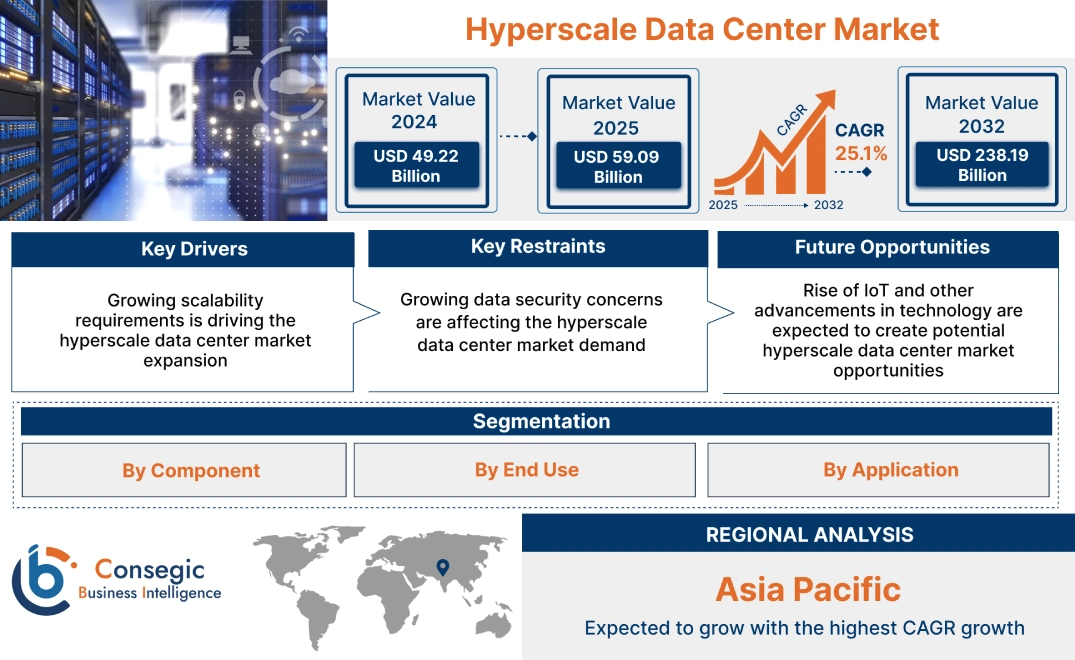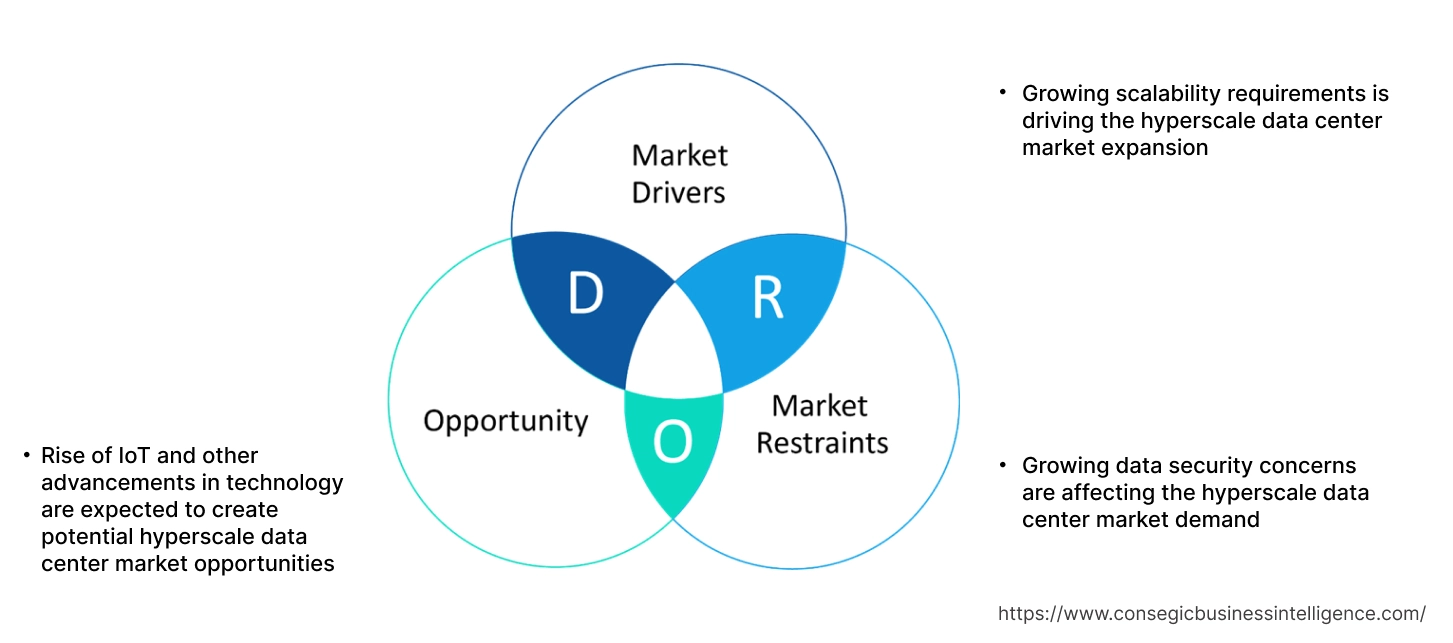- Summary
- Table Of Content
- Methodology
Hyperscale Data Center Market Size:
Hyperscale Data Center Market Size is estimated to reach over USD 238.19 Billion by 2032 from a value of USD 49.22 Billion in 2024 and is projected to grow by USD 59.09 Billion in 2025, growing at a CAGR of 25.1% from 2025 to 2032.
Hyperscale Data Center Market Scope & Overview:
Hyperscale data center is a massive and highly scalable facility, which is designed to manage enormous computing and storage demand for large-scale applications and services. These data centers are distinguished by their ability to rapidly scale up or down to accommodate fluctuating workloads, leveraging advanced technologies and innovative architectures to achieve unprecedented levels of performance, reliability, and energy efficiency.
Key Drivers:
Growing scalability requirements is driving the hyperscale data center market expansion
Scalability requirements are a crucial driver in the global market, reflecting the necessity for infrastructure that can seamlessly expand to accommodate growing data volumes and user demands. As businesses increasingly rely on digital operations and data-driven decision-making, the scalability of data center infrastructure plays a crucial role. Moreover, automation plays a pivotal role in enabling this scalability by automating provisioning, configuration, and management processes, allowing data centers to dynamically adjust resources based on workload fluctuations. This flexibility ensures that organizations can scale their operations efficiently without compromising performance or incurring unnecessary costs.
Data center automation facilitates this scalability by automating the deployment and management of cloud infrastructure, enabling organizations to leverage the benefits of cloud computing without the complexity of manual intervention. Additionally, virtualization technologies enable the creation of scalable, software-defined environments, where automation can dynamically allocate and optimize resources to meet workload demands in real-time.
- For instance, in October 2022, Augtera Networks, announced its support for AMD Pensando DPUs, which will enable purpose-built network artificial intelligence (AI) in next generation hyperscale data centers. By automating anomaly detection, problem root identification, noise elimination, and alerting of collaboration and ticketing applications like Slack and ServiceNow, Augtera Network AI makes network administration easier.
Thus, according to the hyperscale data center market analysis, the growing scalability requirements and advancements in data center automation are driving the hyperscale data center market size and trends.
Key Restraints:
Growing data security concerns are affecting the hyperscale data center market demand
Security concerns are major issue in the data centers as organizations struggle with the complexities of safeguarding their automated processes and infrastructure. The automation of critical tasks within data centers introduces new vulnerabilities and malicious attackers can exploit. Moreover, data center automation origins from the interconnection of systems and devices. As automation optimizes workflows across heterogeneous environments comprising physical, virtual, and cloud-based resources, the attack surface widens, presenting opportunities for cyber attackers.
Further, the increasing use of APIs (application programming interfaces) and integration points for automation further complicates security management, as these interfaces can become potential entry points for cyber-attacks if not properly secured. Therefore, the aforementioned factors would further impact the hyperscale data center market size.
Future Opportunities :
Rise of IoT and other advancements in technology are expected to create potential hyperscale data center market opportunities
The integration of internet of things (IoT) and AI technology represents a significant evolution in data center infrastructure management and capabilities. As the proliferation of connected devices continues to grow across industries, hyperscale data centers are increasingly adopting IoT solutions to enhance operational efficiency, optimize resource utilization, and improve overall performance of business operations. By leveraging IoT sensors and edge computing capabilities, data center operators can monitor temperature, humidity, power usage, and other critical parameters in real-time, enabling proactive maintenance, troubleshooting, and optimization of data center infrastructure. This real-time monitoring capability enhances reliability, reduces downtime, and improves energy efficiency, contributing to overall cost savings and operational excellence.
- For instance, December 2024, Prometheus Hyperscale has selected Lumen Technologies, to integrate their data centers to meet AI data needs. Lumen will help Prometheus with the rapid growth in cloud computing, big data, AI, and IoT, as they address the crucial environmental challenges faced by the AI industry.
Thus, based on the above hyperscale data center market analysis, the rising adoption of IoT and other advancements in technology are expected to drive the hyperscale data center market opportunities.
Hyperscale Data Center Market Segmental Analysis :
By Component:
Based on component, the market is segmented into solution and service.
Trends in the component:
- As businesses continue to generate vast amounts of data, there is a growing need for data center infrastructure and components that can efficiently process and analyze this information.
- The rise of artificial intelligence (AI) and machine learning (ML) applications has further increased the need for advanced data center infrastructures. To meet these demands, data center service providers are innovating and expanding their service portfolios, while offering tailored solutions that address specific requirements and compliance standards.
- Thus, the above factors are driving the hyperscale data center market demand.
The solution segment accounted for the largest revenue share in the year 2024.
- The growing emphasis on edge computing, driven by the proliferation of IoT devices and the need for low-latency data processing, are driving the need for edge data centers and related solutions.
- The need for real-time data processing and analysis in latency-sensitive applications such as industrial automation, smart cities, and augmented reality/virtual reality (AR/VR) is driving the need for data center solutions.
- For instance, in August 2024, Agartala city has deployed data centre solutions for their integrated command and control center. The new data centre covers all aspects of smart city, including traffic signals, CCTV cameras, LED display boards, and weather information.
- Thus, based on the above analysis, these factors are further driving the hyperscale data center market growth.
The service segment is anticipated to register the fastest CAGR during the forecast period.
- Data center services encompass a broad spectrum of offerings, including design and consulting, installation and deployment, support and maintenance, and managed services.
- These services are crucial in helping businesses streamline their IT operations, reduce costs, and enhance overall productivity by leveraging advanced data center technologies.
- The growing requirement for green data center services reflects a rising emphasis on sustainability and environmental responsibility within the global data center market.
- Further, governments and regulatory bodies are incentivizing green initiatives through tax incentives, grants, and favourable policies, further driving the adoption of green data center services.
- Thus, based on the above analysis, the above factors are expected to drive the hyperscale data center market share and trends during the forecast period.
By End-Use:
Based on end-use, the market is segmented into cloud providers, colocation providers, and enterprises.
Trends in the end-use:
- The need for reliable and secure infrastructure to support mission-critical applications and ensure business continuity is driving organizations to partner with colocation and managed hosting providers with better facilities and stringent security measures.
- The emergence of edge computing, where data processing occurs closer to the point of data generation, is creating new prospects for service providers to offer services tailored to the unique requirements of edge deployments for end users.
The enterprises segment accounted for the largest revenue share of 53.05% in the year 2024.
- Enterprises, comprising a diverse spectrum of industries ranging from finance and healthcare to retail and manufacturing, constitute a significant segment of hyperscale datacenter consumers.
- These organizations harness hyperscale infrastructure to drive digital transformation initiatives, enhance operational efficiency, and accelerate innovation across their business operations.
- By leveraging the scalability, performance, and flexibility of hyperscale datacenters, enterprises can effectively manage the overloading of data generated by their operations, unlock actionable insights, and deliver superior products and services to customers.
- For instance, in June 2022, Equinix Inc. announced the partnership with PGIM Real Estate, to open first xScale data centers in Sydney for hyperscalers. The date centers will be utilized and operated under the joint venture of USD 575 million and meet need for cloud-based platforms and services among enterprises in Australia.
- Thus, based on the above analysis, these factors would further supplement the hyperscale data center market
The cloud providers segment is anticipated to register the fastest CAGR during the forecast period.
- The rising adoption of cloud-based solutions and the need for high-speed, low-latency networks are driving the need for data center services for cloud providers.
- Companies rely on skilled deployment teams to minimize downtime and ensure a seamless transition during the setup process.
- Cloud solutions allow businesses to access IT resources on-demand through a third-party provider's infrastructure, eliminating the need for extensive capital investments in physical hardware. This flexibility enables cloud providers to rapidly deploy applications, scale resources as needed and optimize operational efficiency while benefiting from managed services that ensure better security, reliability, and compliance with industry standards.
- These factors are anticipated to further drive the hyperscale data center market trends during the forecast period.
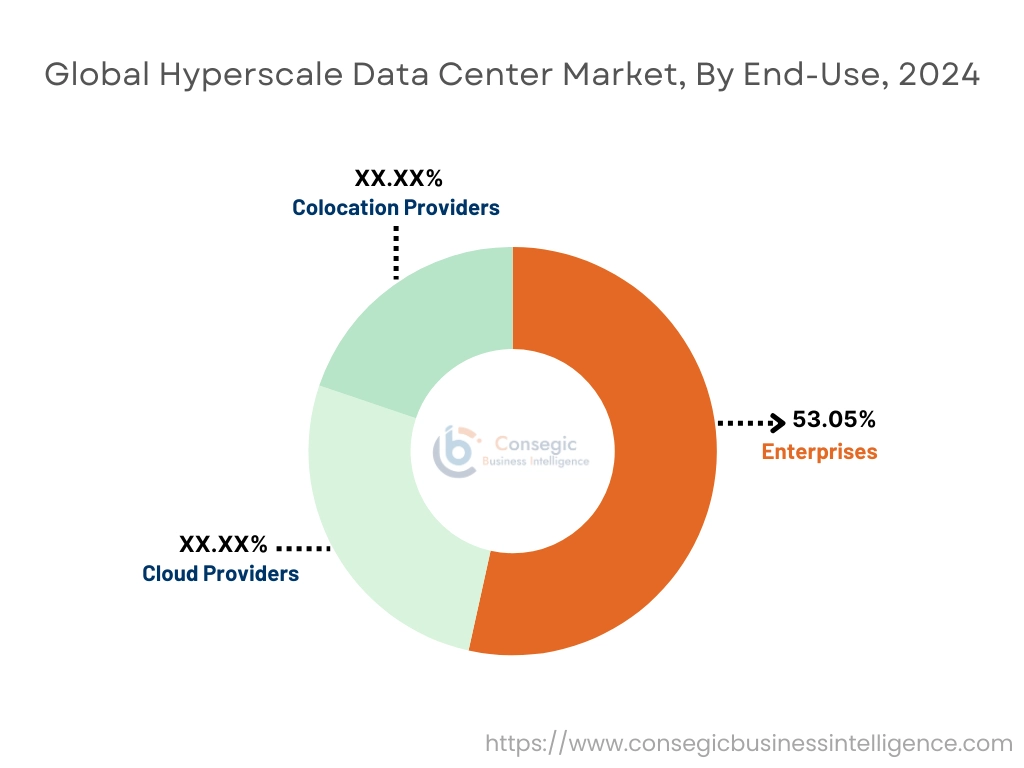
By Application:
Based on application, the hyperscale data center market is segmented into BFSI, retail & e-commerce, government, IT & telecom, entertainment & media, and others.
Trends in the application:
- The data centers often integrate advanced technologies to improve performance, enhance security, and support business continuity. These solutions are critical for several industries that require high availability and custom-built infrastructure tailored to their specific business operations.
- The growing need to support huge data storage and processing needs is driving the adoption of large-scale data centers, which caters to industries such as e-commerce, telecommunications, and IT services.
The IT & telecom segment accounted for the largest revenue in the year 2024.
- As the need for faster internet speeds, cloud services, and data storage increases, telecom and IT companies require high-performance infrastructure to meet the growing needs of businesses and consumers.
- The large scale data centers enable IT and telecom companies to support exponential data growth, deliver low-latency connectivity, and enhance service reliability, driving digital transformation initiatives and facilitating the adoption of emerging technologies such as 5G, edge computing, and internet of things (IoT).
- For instance, in April 2025, ST Telemedia announced the plan to open new AI-ready data center in Kolkata, India, to support the growing needs of AI computing with advanced cooling systems, high-density rack configurations, and better modular design. It will boost digital infrastructure in the eastern part of the country, with a capacity of 25MW of overall IT load.
- Thus, based on the above analysis, these factors are driving the hyperscale data center market growth and trends.
The BFSI segment is anticipated to register the fastest CAGR during the forecast period.
- The BFSI sector is one of the largest adopters of data center solutions, as these institutions rely heavily on secure and high-performing infrastructure to handle sensitive financial data and transactions.
- With increasing digitalization in the financial sector, the need for reliable and scalable data center solutions is anticipated to rise, providing a strong environment for financial operations.
- Financial institutions leverage hyperscale infrastructure to handle massive data volumes, ensure low-latency access to financial data, and enhance cybersecurity capabilities to protect sensitive customer information and comply with regulatory requirements.
- These factors are anticipated to drive the hyperscale data center market trends during the forecast period.
Regional Analysis:
The global market has been classified by region into North America, Europe, Asia-Pacific, Middle East & Africa (MEA), and Latin America.
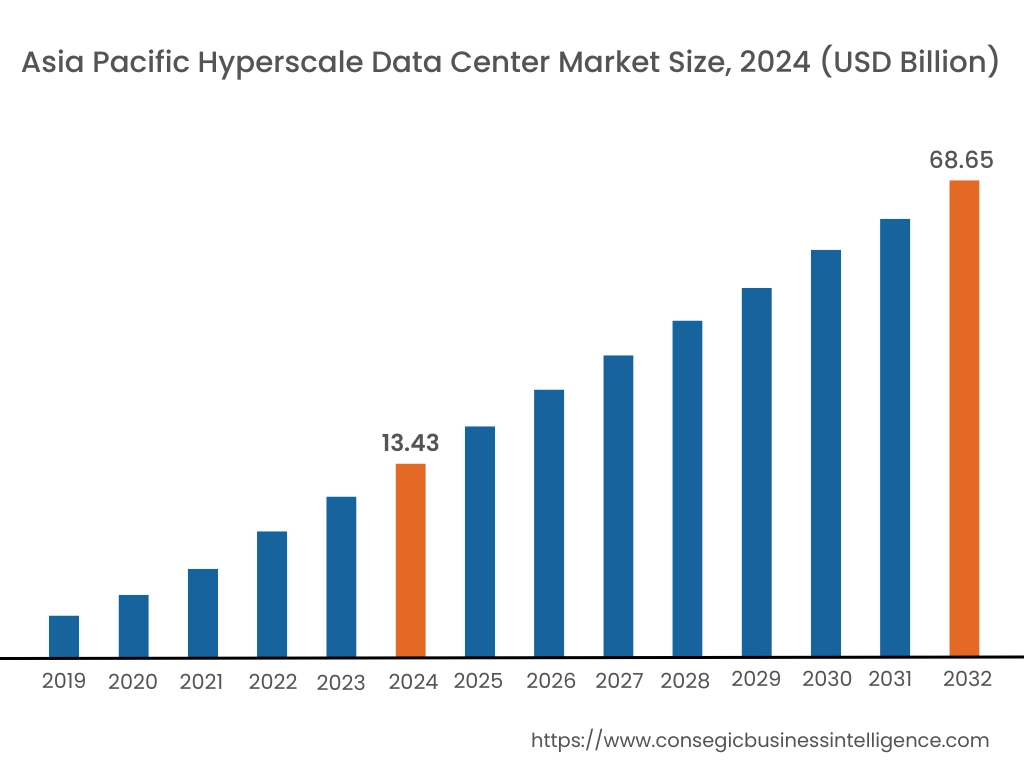
Asia Pacific hyperscale data center market expansion is estimated to reach over USD 68.65 billion by 2032 from a value of USD 13.43 billion in 2024 and is projected to grow by USD 16.20 billion in 2025. Out of this, the China market accounted for the maximum revenue split of 38.91%. The regional growth can be attributed to the rapid urbanization, growing internet penetration, and proliferation of mobile devices. Countries in the region are witnessing substantial investments in data center infrastructure to support the expanding digital economy and address the growing need for cloud services, e-commerce, and digital content consumption. Additionally, the emerging markets in Southeast Asia presents significant prospects for market players to capitalize on the region's evolving IT landscape and growing need for advanced data center solutions. These factors would further drive the regional hyperscale data center market during the forecast period.
- For instance, in May 2022, NTT India announced the launch of new hyperscale data center campus in Navi Mumbai, to strengthen its position as a key market player in India. The data centre is spread across 400,000 square feet and provides capacity to host 5,000 racks. Further, the data center also support over 30MW of IT load.
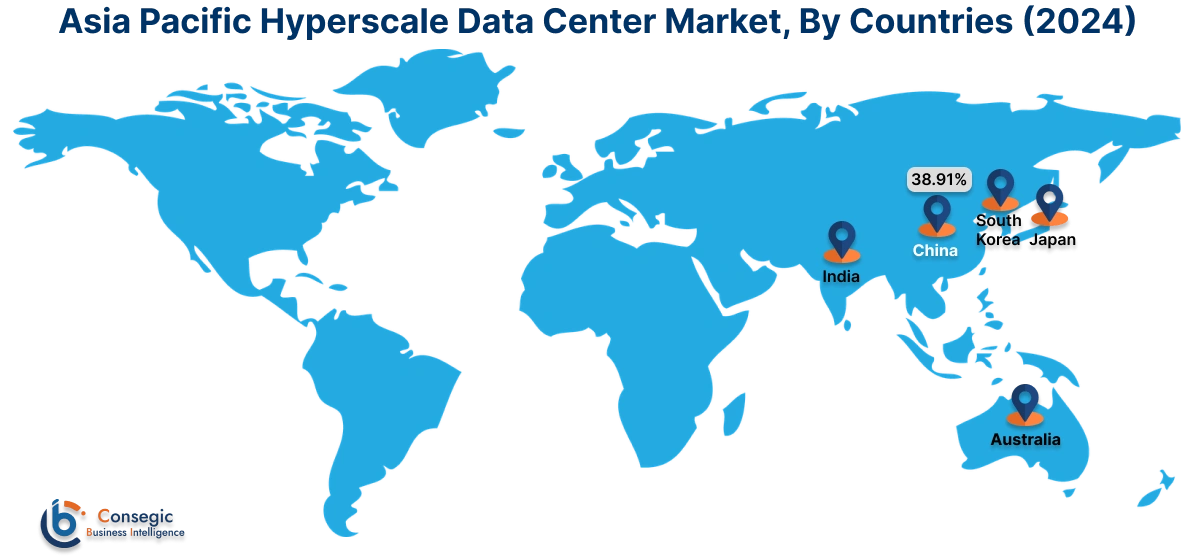
North America market is estimated to reach over USD 92.47 billion by 2032 from a value of USD 19.21 billion in 2024 and is projected to grow by USD 23.05 billion in 2025. North America emerges as a dominant region in the hyperscale datacenter landscape, fueled by the presence of major technology hubs, robust internet infrastructure, and a high concentration of hyperscale data center operators. The region's advanced technological ecosystem, coupled with increasing need for cloud services and big data analytics, drives significant investments in data center infrastructure. Additionally, stringent regulatory frameworks and compliance requirements drive investments in advanced security and data management solutions, further boosting market growth. These factors would further drive the regional market share during the forecast period.
- For instance, in October 2024, Equinix announced the joint venture of USD 15 billion with GIC and Canada Pension Plan Investment Board, to expand of the footprint of hyperscale datacentres in U.S. With this strategic collaboration, the companies will deploy AI technologies in their business operations, catering the need for storage and computing power provided by data centers.
Additionally, according to the analysis, the hyperscale data center industry in Europe is projected to witness significant development during the forecast period. Europe, with its diverse economy and stringent data protection regulations such as GDPR, holds a significant share in the global market. Countries in the region are leveraging advanced IT infrastructure and strong emphasis on sustainability to fuel market development.
Further, in Latin America, the increasing adoption of hybrid cloud architecture and edge computing technologies across industries further drives the need for scalable and efficient data center solutions in the region. Further, in the Middle East and Africa, the market has significant growth potential, driven by increasing internet connectivity, digital transformation initiatives, and investments in critical infrastructure. Further, countries in this region are key hubs for hyperscale datacenter deployments, driven by the growing need for cloud services, expanding e-commerce ecosystems, and digital transformation initiatives.

Top Key Players and Market Share Insights:
The global hyperscale data center market is highly competitive with major players providing solutions to the national and international markets. Key players are adopting several strategies in research and development (R&D), product innovation, and end-user launches to hold a strong position in the market. Key players in the hyperscale data center industry include-
- Google (U.S.)
- Broadcom (U.S.)
- IBM Corporation (U.S.)
- Microsoft Corporation (U.S.)
- Schneider Electric SE (France)
- Cisco Systems Inc. (U.S.)
- Dell Inc. (U.S.)
- Amazon Web Services (U.S.)
- Equinix Inc. (U.S.)
- Huawei Technologies Co., Ltd. (China)
Recent Industry Developments :
Expansion:
- In February 2024, Blackstone Group and its partner Panchshil Realty built a largest hyperscale data center in Navi Mumbai, India, with a capacity of 500 MW. The data centre will run on 65% green and renewable energy and spanned across 14 buildings with over 3 million square feet development.
Hyperscale Data Center Market Report Insights :
| Report Attributes | Report Details |
| Study Timeline | 2019-2032 |
| Market Size in 2032 | USD 238.19 Billion |
| CAGR (2025-2032) | 25.1% |
| By Component |
|
| By End Use |
|
| By Application |
|
| By Region |
|
| Key Players |
|
| North America | U.S. Canada Mexico |
| Europe | U.K. Germany France Spain Italy Russia Benelux Rest of Europe |
| APAC | China South Korea Japan India Australia ASEAN Rest of Asia-Pacific |
| Middle East and Africa | GCC Turkey South Africa Rest of MEA |
| LATAM | Brazil Argentina Chile Rest of LATAM |
| Report Coverage |
|
Key Questions Answered in the Report
How big is the Hyperscale Data Center Market? +
Hyperscale Data Center market size is estimated to reach over USD 238.19 Billion by 2032 from a value of USD 49.22 Billion in 2024 and is projected to grow by USD 59.09 Billion in 2025, growing at a CAGR of 25.1% from 2025 to 2032.
Which is the fastest-growing region in the Hyperscale Data Center Market? +
Asia-Pacific is the region experiencing the most rapid growth in the market.
What specific segmentation details are covered in the Hyperscale Data Center report? +
The hyperscale data center report includes specific segmentation details for component, end-use, application, and region.
Who are the major players in the Hyperscale Data Center Market? +
The key participants in the market are Google (U.S.), Broadcom (U.S.), Cisco Systems Inc. (U.S.), Dell Inc. (U.S.), Amazon Web Services (U.S.), Equinix Inc. (U.S.), Huawei Technologies Co., Ltd. (China), IBM Corporation (U.S.), Microsoft Corporation (U.S.), Schneider Electric SE (France), and others.
